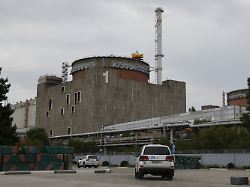“New Difficulties”
IAEA: Zaporizhia NPP cooling pond under pressure
06/09/2023, 11:55 p.m
The Zaporizhia NPP can still be cooled even after the dam on the Dnipro burst. However, the IAEA is now focusing on another problem: Because the water level outside the dam around the reactor’s cooling pond has dropped sharply, the pressure on the inside is increasing.
The International Atomic Energy Agency (IAEA) is focusing on the large cooling pond of the Ukrainian nuclear power plant Zaporizhia after the dam burst on the Dnipro. The IAEA in Vienna reported that the pressure on the dike around the pond is increasing on the inside because the level of the dammed river has fallen sharply on the outside. The nuclear authority – which has stationed observers in the Russian-occupied nuclear power plant – is monitoring the situation closely, reported IAEA boss Rafael Grossi.
Europe’s largest nuclear power plant is not threatened in the short term, but the destruction of the Kachowka dam and increasing military activities would cause “significant new difficulties”, according to Grossi. The environmental organization Greenpeace had previously warned of a break in the cooling pond on Friday.
In principle, according to the IAEA, there is enough water in the pond and other areas of the nuclear power plant to cool the decommissioned reactors and spent fuel rods for several months, even if, as a result of the destruction of the dam, water will soon no longer be pumped from the sinking Dnipro reservoir could become.
The nuclear power plant “continues to pump cooling water out of the Kachowka reservoir,” the IAEA said. Even if the water level is below the critical threshold of 12.70 meters, the pumping process can continue. This gives a little more time “before we may have to switch to other sources of supply,” said IAEA chief Rafael Grossi, who plans to visit Europe’s largest nuclear power plant the day before next week. If the dam is no longer intact, the power plant can fall back on “a large catchment basin nearby, as well as smaller reserves and wells on site that can supply cooling water for several months,” Grossi said. Nevertheless, the situation remains “very uncertain and potentially dangerous,” he emphasized.
The reactors of the nuclear facility occupied by the Russian army have already been shut down. However, the fuel in the reactor cores and in the storage pools must be constantly cooled to prevent a core meltdown.
